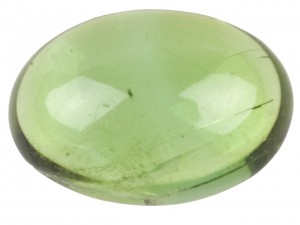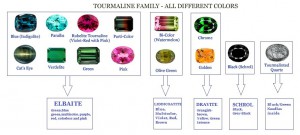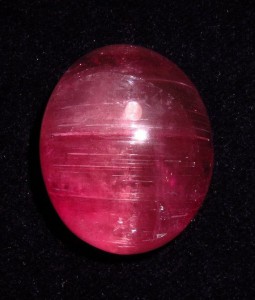Green Tourmaline (61TR JJMV)
‘Tourmaline’ is a general family name for gemstones which have a complex borosilicate crystal structure. It comes in a huge variety of different colours, each of which is named individually. Some of the more distinctive varieties, like the Watermelon Tourmaline, are easily recognised and quite readily available, but there are other more exotic examples which you may not be quite so familiar with.
Tourmaline Family of Gemstones (Image Source: Navneet Gems)
One of the most desirable and rarest forms of tourmaline is the Paraiba, so called because of its origin in Paraiba in Brazil. In general terms most blue tourmaline is known as indicolite or indigolite – it is usually quite dark in colour, but is often heat treated to lighten it thus making it more desirable. Paraiba Tourmaline however, is a relatively recent discovery and is a naturally occurring, neon bright blue stone, which makes it extremely valuable and much sought after by collectors. Discovered in the 1980s by Heitor Dimas Barbosa, Paraiba Tourmaline gets it distinct colour from trace elements of copper which can result in anything from bright turquoise to a more sedate blue/green. Such is the rarity of these stones that most fine examples sold at auction will achieve five figure amounts per carat.
The value of tourmaline varies enormously, and if you are not one of the fortunate few who are lucky enough to own a Paraiba, there is still a good selection of other options within the family to suit all budgets. At the opposite end of the scale you have the ‘Schorl’ stones which are the extremely common black, iron rich, opaque crystals of tourmaline. They have little value as gemstones today, but were extensively used during the Victorian era for mourning jewellery.
If red/pink stones are more to your taste then Rubellite (Tourmaline) might well be the order of the day. The crystals generally form within weathered granites, and can appear either as a translucent stone or with a cats-eye appearance thanks to its fibrous habit. The evidence of this can be clearly seen when cats-eye rubellite is cut en cabochon.
Cat’s Eye Rubellite (Tourmaline)
One of the most distinctive forms of tourmaline has to be the Watermelon variety, my favourite and so named because of its combination of dark pink and green within one crystal, which is reminiscent of the fruit. It is not unusual for tourmalines to contain more than one colour within a single crystal, with some exhibiting as many as 15! However, the Watermelon colour combination is one of the most characteristic of tourmaline and makes a fabulous central stone for a show stopping piece of jewellery.
In practical terms tourmaline is considered a fairly stable gem, measuring 7-7.5 on Mohs scale of hardness. It can cope with exposure to chemicals quite well, but what it can’t withstand is contact with heat and extreme changes of temperature which may well cause it to fracture. There is a tendency for tourmalines to have liquid filled inclusions which will expand when heated, causing the crystal to split. Many stones are heat treated or irradiated to improve their colour, so subsequent exposure to heat will cause tourmaline to change colour again. For that reason ultrasonic and steam cleaners are best avoided, with warm soapy water being the safest option for cleaning.
A range of green and pink tourmaline gemstones are now available to purchase from Cooksongold – why not add some colour and try including one of these in your next piece?


Cooksongold



